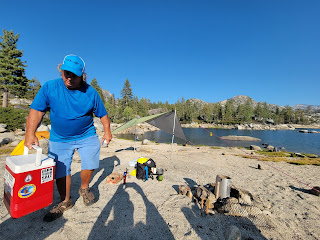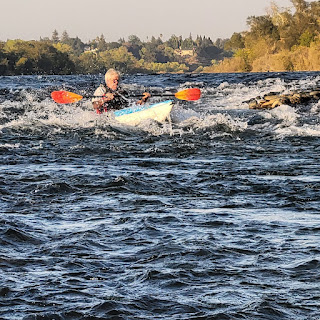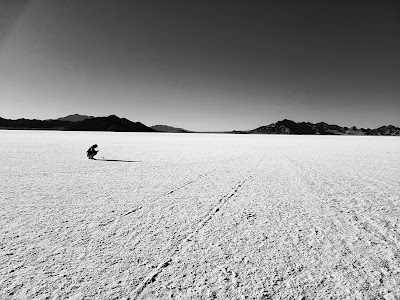 |
| White House on the Potomac, 1836-37 White House Collection/The White House Historical Association |
"Life is a great adventure…accept it in such a spirit. --Theodore Roosevelt
In the spirit of President’s Day, we salute those who have answered the call to higher office in service to our nation as President of the United States. From the high to lows, these men have shaped our country's history and standing around the free world. As Abraham Lincoln said, ”The Presidency, even to the most experienced politicians, is no bed of roses; and General Taylor like others, found thorns within it. No human being can fill that station and escape censure." But for some presidents, the river called and kept calling, offering adventure and liberation from the burden of our highest office.
In the early days of our fledgling nation, our country's rivers were natural highways allowing for westward expansion and transporting raw materials such as lumber, fur, food, and other supplies. Our early canoeing presidents identified with this need to explore our seemly less endless waterways.
Thomas Jefferson called the Ohio River the most beautiful river on earth. "Its current gentle," he went on, "Waters clear, and bosom smooth and unbroken by rocks and rapids, a single instance only excepted."
As river traffic began to decline by the 1870s, thanks to trains, a coinciding interest in nature emerged producing a new recreational activity called tourism. Affluent citizens and presidents were now flocking to scenic lake and river locations for fishing, canoeing, boating, for rest and relaxation.
Wisconsin's Brule River is often called the River of Presidents because five United States Presidents have visited and to fish the north woods river, Ulysses S. Grant, Grover Cleveland, Calvin Coolidge, Herbert Hoover, and Dwight Eisenhower.
Modern-day presidents dedicated themselves to environmental awareness and pledging to keep rivers running wild. It was President Lyndon Johnson who advocating for the Wild & Scenic Rivers Act in the 1960s who said, "The time has also come to identify and preserve free-flowing stretches of our great scenic rivers before growth and development make the beauty of the unspoiled waterway a memory.”
For many presidents, the call of the river poured into in their souls, making them who they were and guiding them on their path as president.
Here are 6 paddling presidents and their exploits on the water before, after and even during their presidency.
 |
| Daniel Huntington 1816-1906 |
Traveling with the Ohio Company’s representative Christopher Gist on horseback, foot, and canoe across the Appalachians all the way to Ohio River and then up almost to the shores of Lake Erie Washington had various meetings with the Indian Chiefs of the area.
After delivering their message to the French, who said thanks but no thanks, the two found themselves double-crossed by their guide and on the run from hostile from Indians in the middle of winter.
Upon reaching the Allegheny River, they fashion a raft together in an attempt to cross it.
"I put out my setting pole to try to stop the raft, that the ice might pass us by," wrote Washington in his journal, "When the rapidity of the stream threw it with so much violence against the pole that it jerked me out into ten feet water, but I, fortunately, saved myself by catching hold of one of the raft logs; notwithstanding all our efforts we could not get the raft to either shore, but were obliged, as we were near an island, to quit our raft and make to it."
Wet, numb and exhausted they spent a miserable night on the island unable to make a fire. In the morning, luckily they had found the river was totally frozen so they were able to walk to the shore and continue on to Virginia and on to becoming the first president of the United States.
Thomas Jefferson 1801 to 1809 Though there little if anything was written about Jefferson ever paddling in a canoe, there is one thing we know for sure. He was obsessed with the rivers of the interior of what would later become the United States. In sending Lewis & Clark on perhaps the greatest paddling expedition he wrote,
"The object of your mission is to explore the Missouri river, & such principal stream of it, as, by it’s course & communication with the waters of the Pacific ocean, may offer the most direct & practicable water communication across this continent, for the purposes of commerce."
With a river and canoe trails named in his honor, it would be hard to leave him out of our group of river presidents.
 |
| Thomas Hart Benton 1889-1975 |
Yet unlike Henry David Thoreau and John Muir, Lincoln was not a naturalist and thought of waterways as something tamed and advocated improving and clearing the rivers to accommodate large boats for commerce. In 1849 he even filed a patent application for a boat buoying system to raise boats in shallow water.
Undoubtedly Lincoln had a deep appreciation for Illinois' Sangamon River. He was looking for a bit of adventure when the 21-year-old Lincoln and his cousin paddled away from the homestead in a newly purchased canoe in spring 1831. He didn't get far before being hired on to a crew building a Mississippi style flatboat at a river encampment near Sangamo Town. When built he and others would transport cargo and goods all the way down to New Orleans.
Every bit a riverman, the young Lincoln was described by one of the locals as "the rawest, most primitive-looking specimen of humanity I ever saw. Tall, bony, and as homely as he has ever been pictured.”
During construction of the boat, a tale is told how young Lincoln rescued two co-workers from the icy waters after they capsized their canoe and were swept downriver cling to an overhanging tree. Lincoln tied a long rope to a log and drop it into the current. As were others holding the rope, he jumped aboard the floating plank wrapping his legs around the log and drifted it towards the tree and men. Once the men were able to grab on to the log, he singled the others to pull them back like a fish on a hook.
That dramatic log rescue made Lincoln a bit hero along the river. But as he would later say, “It often requires more courage to dare to do right than to fear to do wrong.”
What more could you expect from the president who went on to save the union?
 |
| Illustration from August 1886 |
He defended himself and the honor of all fishermen accused of being lazy in the Saturday Evening Post when he wrote, "What sense is there in the charge of laziness sometimes made against true fishermen? Laziness has no place in the constitution of a man who starts at sunrise and tramps all day with only a sandwich to eat, floundering through bushes and briers and stumbling over rocks or wading streams in pursuit of elusive trout. Neither can a fisherman who, with rod in hand, sits in a boat or on a bank all day be called lazy—provided he attends to his fishing and is physically and mentally alert at his occupation.”
Cleveland also published a book in 1901, called Fishing and Shooting Sketches, displaying his humor and love of the outdoors. He would write, "In these sad and ominous days of mad fortune chasing, every patriotic, thoughtful citizen, whether he fishes or not, should lament that we have not among our countrymen more fishermen."
Theodore Roosevelt 1901 to 1909 He would be arguably our most adventuresome president. A cowboy, a soldier. a big game hunter and a river explorer, Roosevelt lived what he preached the “strenuous life.”
 |
| Library of Congress |
A fierce naturalist and warrior for wildlife and wild places he left an enduring legacy through policy and legislation still felt today. As president, he designated five national parks and created programs that would protect 230 million acres of land.
"All life in the wilderness is so pleasant that the temptation is to consider each particular variety, while one is enjoying it, as better than any other," he said "A canoe trip through the great forests, a trip with a pack-train among the mountains, a trip on snow-shoes through the silent, mysterious fairy-land of the woods in winter--each has its peculiar charm."
After losing the 1912 election to Woodrow Wilson, Roosevelt accepted an opportunity to explore an uncharted tributary of the Amazon: the mysterious Rio da Dúvida, or River of Doubt. Despite little experience with the South American jungle, the burly 55-year-old ex-president called it his “last chance to be a boy,”
Traveling along the winding jungle waterway, the expedition was plagued by tropical illnesses, lack of supplies, alligators, piranhas, venomous snakes, and hostile native tribes, but mostly miles of tortuous rapids.
Roosevelt's crew were forced to either portage their boats on their backs through the dense jungle or shoot the whitewater rapids in their canoes. On one such occasion, one crewman drowns after attempting to run a waterfall.
Injured and sick Roosevelt finished the two-month river odyssey more dead than alive and never quite recovered. He died in his sleep in 1919 at the age of 60, but by then, the river of Doubt had a new name. It's now called the Roosevelt River.
 |
| Wisconsin Historical Society |
Accompanied by his Indian guide, John LaRock, he could while away the hours fishing from his canoe which he appley named "Beaver Dick." It was a much more innocent time back then, so you'll have to take our word for it and not Google search this, but it was said he named it after the legendary mountain man Richard “Beaver Dick” Leigh who lived in the Tetons and Yellowstone area in the 1860s.
For Coolidge who had decided not to run for re-election as president and the canoeing and fishing seemed to take over his time that summer.
“These are true outdoor sports in the highest sense," said Coolidge, "And must be pursued in a way that develops energy, perseverance, skill, and courage of the individual."
However, many denounced his passion for paddling and fishing while ignoring his presidential duties. The nearby Duluth Herald reported, “Paddling a canoe up the Brule river is more interesting to President Coolidge than the Democratic national convention which opened at Houston today. Attention to business routine and recreation are again on the schedule today, with the president more anxious to master the paddling of a canoe against the Brule rapids than in learning what is going on at the … convention.”
When he left later that summer, he told the people he hoped to return someday but never did. He died a few years later during the height of the Great Depression and the birch bark canoe the Beaver Dick floated away into history.
Jimmy Carter 1977 to 1981 In 1974, the strumming and picking of Dueling Banjos were still reverberating through the hills along Georgia's Chattooga River when Carter and his paddling partner Claude Terry canoed its free-flowing whitewater that was the backdrop to the movie, Deliverance.
Having grown up along a small creek in rural Georgia, Carter came to appreciate the water, but it was his time on the Chattooga that gave rebirth to his passion for wild rivers.
"The Chattooga was the first time I ever risked my life, I would say, in going down a wild river," Carter said in the short film Wild President by NRS and American Rivers celebrating the 50th Anniversary of the Wild and Scenic Rivers Act.
 |
| Courtesy of Doug Woodward and American Rivers |
"There is a religious experience in coming over top of a huge rapid and burying your bowman’s face down until you maybe can’t see him,” Terry recalled in the film about their adventurous canoe run.
"I think it gave me a sense of heroism in confronting the awe-inspiring power Chattooga," Carter would add.
That experience transformed his life and shape his political career, just as it did Teddy Roosevelt's. He became a staunch supporter of the environmental causes and protector of wild rivers. Shortly after the river run, Carter successfully pushed to designate 57 miles of the Chattooga as Wild & Scenic.
As president, his administration designated more than 40 new Wild and Scenic Rivers, protecting over 5,300 miles of what can be thought of as our National Parks for rivers.
“My motivation was trying to preserve the beauty of God’s world,” said Carter said in the film, “I think it’s very important for all Americans to take a stand, a positive stand, in protecting wild rivers. I hope that all Americans will join together with me and others who love the outdoors to protect this for our children and our grandchildren.”












































